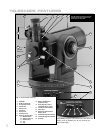
MEADE ETX: YOUR PERSONAL
WINDOW TO THE UNIVERSE
The Meade ETX-90AT, ETX-105AT and the ETX-125AT are extremely versatile, high-
resolution telescopes. With pushbutton controls, automatic tracking of celestial
objects and diffraction-limited imaging, an ETX telescope may be all the telescope
ever required by many terrestrial and astronomical observers.
Your ETX telescope reveals nature in an ever-expanding level of detail. Observe the
feather structure of an eagle from 50 yards or study the rings of the planet Saturn from
a distance of 800 million miles. Focus beyond the Solar System and observe
majestic nebulae, ancient star clusters, remote galaxies and even stars recently
discovered to have planets orbiting about them. Meade ETX telescopes are
instruments fully capable of growing with your interest and are ideal for both the
casual observer and serious astronomer alike.
Telescope Controls
Become acquainted with all of these controls before attempting observations through
the telescope.
B Eyepiece: Place the supplied 26mm eyepiece into the 90° Eyepiece Holder (4,
Fig. 1
) and tighten in place with thumbscrew (3, Fig.1).
C
Viewfinder
ETX-90AT
:
8 x 21mm Viewfinder: Slide the eyepiece end of the viewfinder
through the
front of the viewfinder bracket (Fig. 18).
ETX-105AT, ETX-125AT
:
8 x 25mm Right-Angle Viewfinder: Slide the front cell
end of the viewfinder through the rear of the viewfinder bracket (Fig. 19).
D Eyepiece Holder Thumbscrew: Tightens the eyepiece in place. Tighten to a firm
feel only.
e 90° Eyepiece Holder: Holds the eyepiece upright for easy viewing.
F Optical Tube: The main optical component that gathers the light from distant
objects and brings this light to a focus for examination with the eyepiece.
G Vertical Lock: Controls the manual vertical movement of the telescope. Turning
the vertical lock counterclockwise unlocks the telescope enabling it to be freely
rotated by hand about the vertical axis. Turning the vertical lock clockwise (to a
firm feel only) prevents the telescope from being moved manually, but engages
the vertical motor drive clutch for Autostar operation. When polar aligned, the
vertical lock serves as the Declination or Dec. lock.
Note: The vertical lock knob is a knurled knob located on the fork arm to
the right of the focus knob (8, Fig. 1). Mounted beneath the knob is a cir-
cular scale without numbers. Do not confuse this scale with the Dec.
setting circle (
16, Fig. 1) on the opposite fork arm which has a numbered
scale used to locate astronomical objects.
H Fork Arms: Hold the optical tube in place.
Note: The telescope base and fork mount are designed with internal
“rotational limit stops.” The horizontal limit stop prevents the telescope
from rotating more than 630° to avoid damage to the internal wiring. The
vertical limit stop prevents the viewfinder from striking the fork mount
when the telescope is pointed upward just past 90° and prevents the
optical tube from striking the base if pointed downward more than 30°. Do
not force the telescope to move beyond these stops or damage to the
telescope will result.
i Focus Knob: Moves the telescope’s primary mirror in a finely-controlled motion
to achieve precise image focus. The ETX telescopes can be focused on objects
from a distance of about 11.5 ft (ETX-90AT) or 15 ft (ETX-105AT or
ETX-125AT) to infinity. Rotate the focus knob clockwise to focus on distant
objects and counterclockwise to focus on nearby objects.
Caution:
Using products other than
standard Meade accessories
may cause damage to the
telescope’s internal
electronics and may void the
Meade warranty.
7
B Want to learn more
about the eyepieces
available for your ETX
telescope?
See OPTIONAL
ACCESSORIES
, pages
43 to 44.
c Want to learn how to
attach the viewfinder to
your ETX telescope?
See VIEWFINDER,
pages 13 and 14.
G Want to learn more
about the Right
Ascension and
Declination setting
circles? See page 54.
Caution:
When loosening the Dec.
lock, be sure to support
the optical tube (5 Fig. 1).
The weight of the tube
could cause the tube to
swing through the fork
arms suddenly.


















